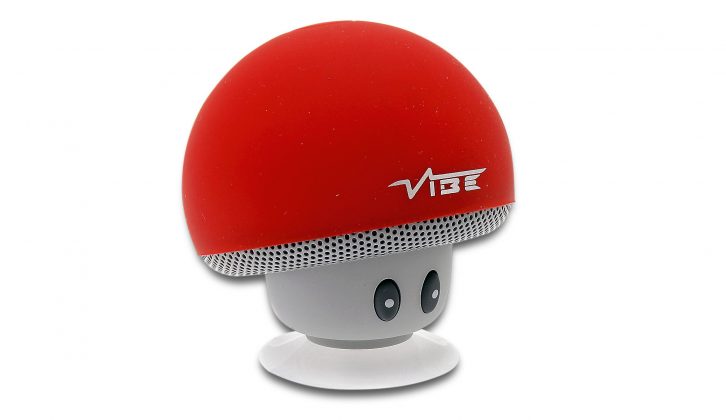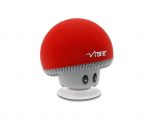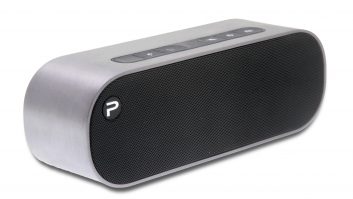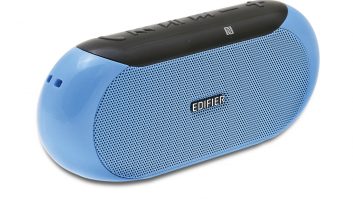Verdict
We like the look of the Fungi Vibe Mushroom from Halfords, and the low price is tempting. However in our test the volume control was not working on the device itself and could not be adjusted remotely from our music playing devices.
It’s cheap and cute, so perhaps that will be enough to keep small children happy on tour, but we don’t think it’ll cut the mustard with anyone older.
Pros
Looks cute
Tiny and ultra portable
Comes in red or blue
Very low price
Cons
The volume control didn’t seem to work
Tinny sound
We’ve been having fun testing the latest portable Bluetooth speakers on the Practical Caravan accessories test bench. And we’re impressed by the quality of sound coming out of some of these tiny devices.
Audio technology has come a long way since Sony first launched its revolutionary Sony Walkman at the very end of the 1970s. The whole idea of wearing headphones and having your favourite music wherever you go was quickly embraced by the public and rival audio equipment manufacturers alike. Despite dire warnings that people were likely to walk into street furniture and worse, we all decided that portable music was the way to go. There was just one problem, the sound quality was tinny and prone to distortion if you turned up the volume. Thankfully, plug-in speakers were invented to fix this problem.
Since then we’ve seen the almost total demise of audio cassette tapes and their players, with CDs and CD players heading the same way. Our busy lives are best suited to the new age of digital downloads that you can store on all your digital devices and play anywhere you go.
This is very handy when we go on caravan holidays, bike rides, picnics and beach trips. All you need is your smartphone, tablet or laptop full of great music, plus a plug-in speaker. And if you choose a portable Bluetooth speaker you’ll be able to use it to enhance the sound quality of all your music, as well as for hands-free phone calls.
We’ve been reviewing a selection of portable Bluetooth speakers on the Practical Caravan test bench. For instance, we tried out the Creative Sound Blaster Free, at £59.99, and the Speedlink XILU, at £22.49. Some of them have better sound quality than others, of course, so this is the main factor in our star rating verdict. We also look for great value for money, and with these products the prices vary from £10 to £129.99. We factored in the overall power of each speaker, and the clarity and quality of the sound output, looking at the whole sonic range.
Ease of use is another thing we consider when testing products for caravan holidays. We also compare how long the speakers can go before you have to charge them up again, whether charging can be done from the mains or only a USB port and whether you can control the speaker from your device. We found that some speakers will only play at one volume unless you press the buttons on the speaker itself. Speakers with their own remote control get around this.
Inputs are another important consideration. While all Bluetooth speakers mainly use Bluetooth signals from a device to play the music, some will also accept analogue signals from an iPod, a computer’s headphone port or even a Walkman or video player. This entails using a conventional auxiliary lead.
Some speakers are compatible with a new alternative technology to Bluetooth – Near Field Communication (NFC) technology. This is handy if you like to have the latest phones and digital gadgets and want to use your speakers with them.
Some speakers also have a tiny memory-card slot and a built-in digital player, so these devices are really self-contained sound systems. This means you don’t need to power up your tablet or drain your phone’s battery with excessive Bluetooth usage to listen to music.
Amazingly, we discovered that some Bluetooth speakers are shower-proof, which makes them ideal for the outdoor life of most caravanners. If you leave it beside your sun lounger and pop to the campsite facilities for a moment, there’s no need to worry if a few drops of rain should fall.
In this review we’ll focus on the Fungi Vibe Mushroom, from Halfords, £10. It’s up against some excellent competition, and Speedlink’s XILU proves that excellent sonic performance can come from the tiniest speakers. Then there’s this one. A distinct lack of power and volume are the first things we noticed about the Vibe Mushroom. The overall tone is tinny, too, just like yesteryear’s mini Walkman speakers. While attempting to increase volume, we discovered that the buttons don’t work quite as they should. In theory, pressing the up button should increase volume or skip to the next track if you hold it down.
On this unit, though, the volume function seemed to be missing completely, a problem made all the worse by the Vibe’s refusal to acknowledge any volume adjustments made on the phone or laptop.
A distinct lack of power and volume are the first things we noticed about the Vibe Mushroom
Technical Specifications
| Colours | Blue or red |
| Suction cup | Mount it on a window or hard surface |
| Portable speaker | Bluetooth enabled |
| Input | Wireless |



